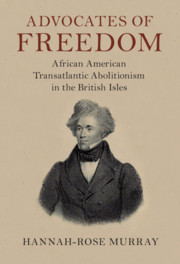Book contents
- Advocates of Freedom
- Slaveries since Emancipation
- Advocates of Freedom
- Copyright page
- Contents
- Figures
- Acknowledgments
- Dedication
- Introduction
- 1 “It Is Time for the Slaves to Speak”
- 2 “All the Bloody Paraphernalia of Slavery”
- 3 “[They Have] Not Ceased to Hold My Hand Since”
- 4 To “Frighten the Hyena Out of His Ferocity”
- 5 “I Would Much Rather Starve in England, a Free Woman, Than Be a Slave”
- 6 “Have No Fellowship I Pray You, with These Merciless Menstealers”
- 7 “My Name Is Not Tom”
- 8 “The Black People’s Side of the Story”
- Conclusion
- Bibliography
- Index
4 - To “Frighten the Hyena Out of His Ferocity”
Black Activism in Britain 1850–1860
Published online by Cambridge University Press: 07 September 2020
- Advocates of Freedom
- Slaveries since Emancipation
- Advocates of Freedom
- Copyright page
- Contents
- Figures
- Acknowledgments
- Dedication
- Introduction
- 1 “It Is Time for the Slaves to Speak”
- 2 “All the Bloody Paraphernalia of Slavery”
- 3 “[They Have] Not Ceased to Hold My Hand Since”
- 4 To “Frighten the Hyena Out of His Ferocity”
- 5 “I Would Much Rather Starve in England, a Free Woman, Than Be a Slave”
- 6 “Have No Fellowship I Pray You, with These Merciless Menstealers”
- 7 “My Name Is Not Tom”
- 8 “The Black People’s Side of the Story”
- Conclusion
- Bibliography
- Index
Summary
Chapter 4 focuses on an era where numerous African Americans visited Britain and exploited the rise of popular abolition after the publication of Harriet Beecher Stowe’s Uncle Tom’s Cabin in 1852. I argue that while activists such as William Wells Brown and the Reverend Samuel Ward manipulated the interest surrounding the novel to maintain antislavery sentiment, they used the opportunity to chastise and even harshly criticize Britain for its role in the slave trade. The chapter also focuses on two other famous figures in the 1850s, Henry ‘Box’ Brown and Frederick Douglass. ‘Box’ Brown refused to bend to any rule in transatlantic activist history, and while he initially incorporated Stowe’s novel into his visual panorama, he used his savvy business flair and did not solely rely on the text. He constantly reinvented himself and his repertoire to court his celebrity, and even starred in a play based on his own life. Lastly, I explore the reasons why Douglass’ exploitation of adaptive resistance in 1859 was comparatively less successful than his first visit in 1845, in part, he believed, because of the growing racism in British society that would become further entrenched during the Civil War.
Keywords
- Type
- Chapter
- Information
- Advocates of FreedomAfrican American Transatlantic Abolitionism in the British Isles, pp. 163 - 196Publisher: Cambridge University PressPrint publication year: 2020



